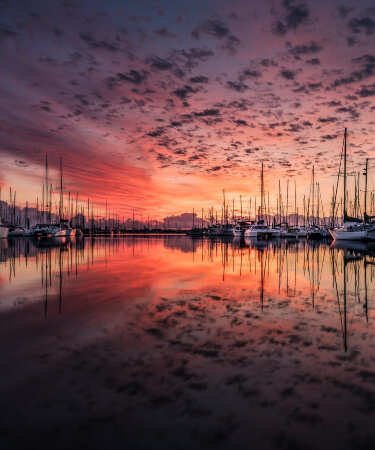Table of Contents
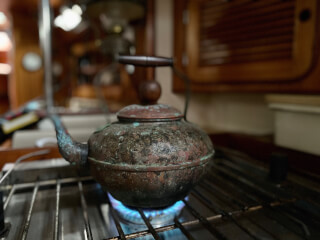
Minimalism Update
Just as we predicted, we overpacked the POD. We had originally scheduled to return the car rental yesterday. It’s now pushed back by a few days. I’m reminded of the sailor’s adage:
Plans are written in the sand at low tide.
By Sunday, we realized that the easier things to tackle got us 50% moved in (clothes, books, some galley and household items). The remaining half would be much harder because there wasn’t a specific place to store these items. They are all taken up by spares (about 60% of the stowage) as we discovered on our last visit. If we stuck to the original “plan,” we would be done by yesterday, but at what expense?
A lot of rash decision-making, exhaustion and stress.
In the process of unpacking, I realized that have an excessive amount of tea, coffee and KIND bars. In teas alone, I have an extensive inventory of Earl Grey, green tea, chai, chamomile, nettle, mint and more. I’ve made a vow not to buy any more tea for a few years so as to make some kind of headway through our stash.
In comparison, the coffee inventory is under control. The KIND bars are not. We have three varieties and four boxes stashed all over the place. And since I hate wasting anything, we may need to resort to a lifecycle culinary experiment with nut bars much like the turkey example.

What’s this sound?
During our second night sleeping aboard, we decided to shut down the air conditioning and let the breeze in to cool the boat. Just then, we heard what sounded like crackling all over the boat. Imagine slowly crumpling cellophane wrap and you’ll get a sense of what we’re hearing.
Could it be bugs?
Once your mind goes there, it’s hard to shake imagining something akin to termites feasting on the wood. The reality is that our interior (which is made of teak throughout) is impermeable to termites, as I learned from Scott Dodgson’s Offshore Explorer podcast.
It’s a little unnerving trying to drift off to sleep hearing these sounds not knowing what they are. Sleep fortunately came, and deep sleep no less, which comes with long days of activity.
The next morning, I did a quick perusal of Women Who Sail and discovered that the sounds came from shrimp, feasting on the algae growing on the hull. I suppose it is symbiotic and somewhat reassuring, but why do they have to be such loud eaters?
Speaking of eating, we’ve frequented Tarpon River Brewing, which is a quarter mile away. They have a variety of tasty brews according to Andrew and we’ve enjoyed all the meals there, including our favorite Firecracker Shrimp.
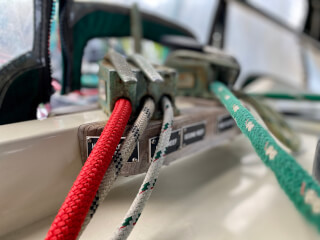
…and that sound?
Everyone who spends time in a marina has heard the clanging of the halyards against the mast. Etiquette calls for sailors to tighten up the line to silence them, and we don’t want to be getting the stink eye from anyone. By the third night, the wind picked up considerably, and our boat started to clang, doubly so since we have two masts. Andrew cinched down main halyard and then went down below to sleep.
The next morning, the clanging came from the staysail and I went forward to tighten that line. A few moments later, the main halyard clanged.
What is this… wack-a-mole?
Our boat neighbor Dave (hereinafter referred to as Richard Cranium at his request) was heading back to his boat, and we apologized for the sound. Rich said not to worry. He likes the sound of halyards clanging. It’s a good indicator of the wind condition. Same goes with the wind generator. Rich went on to describe other sailors who tie down their halyards so tightly as to be polite in the anchorage and leave themselves unprepared. Then he described how he would approach it if we were so inclined to silence our halyard.
Worked like a charm.
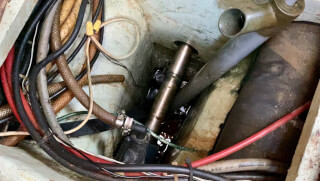
What’s this smell?
When the boat was surveyed in August, Ian instructed Bill to change the fuel lines to comply with insurance requirements. The insurance company insisted on USCG-approved fuel lines and would not accept NZCG-approved hoses. Dutifully, Bill changed them out at his own expense and time, however in the process spilled some diesel into the bilge.
Andrew had been worried that I would find the smell intolerable, and I didn’t. To me, it was a novelty. Regardless, the bilge however needed to be addressed. All the floor boards along the centerline of the boat came up as Andrew traced the fuel lines. Much like the rest of the boat, the bilge had not been cleaned in years.
On Sunday, we spent the morning using a Thirsty Mate contraption to hand pump the water out of the bilge. Five buckets later, the bilge was empty. Then we squirted whatever biodegradable soap and solvents we had on hand and hosed down the interior.
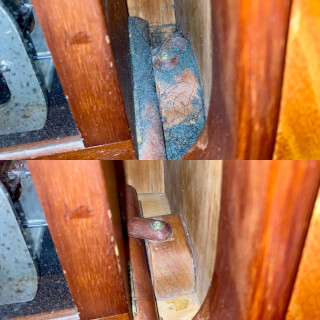
… and that smell?
Really this question could be applied to a variety of areas of the boat. We’re de-funking the boat inside and out. There’s a surface-level cleaning job that seems to pass muster for most crews.
Not for us.
We’re deep cleaning areas behind the lovely teak interior and getting to know our boat, including where water has penetrated and softened some areas, and pay attention to what she will need from us. Hard to reach areas like the one pictured above were ignored over the years. Our process was to vacuum, wipe-down, rinse and repeat.
I’m a tracer!
Everytime I think of the word “trace,” I’m reminded of this scene from Chasing Amy. With boat ownership, comes the responsibility of knowing a little more than what you’re used to when living on land.
Orinarily, we would rely on mechanics, electricians, plumbers, etc. to handle maintenance. However, in order to make this life affordable and to be self-sufficient, Andrew and I are taking all of this on. For us, the best way to start learning is to start tracing.
We are tracers!
… and we embrace our station in life.
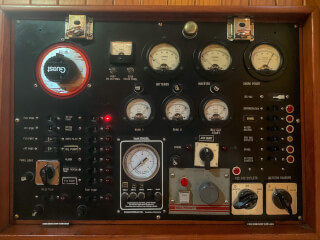
Tracing Boat Systems
A few weeks before we set out for this trip, we tried to get up to speed on electrical systems. While we can totally geek out on this topic, we decided to take a practical approach and understand electrical systems and wiring. We would do this by creating our own diagram of what’s going on behind the panels.
After reviewing a few Pacific Yacht Systems videos, we were inspired to spend a few days mapping out the wiring from shore/solar/alternator to batteries including charge regulators, jotting down the wire and fuse sizes that were installed, battery switches, breaker panels, etc. and comparing this information to Bill’s diagrams.
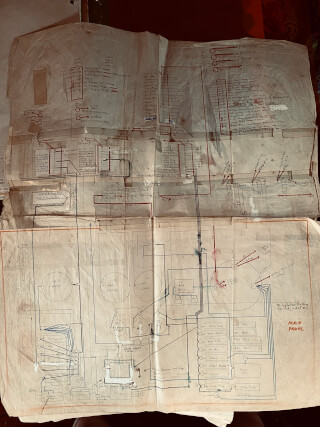
Wiring Diagram
Here’s what we uncovered from the archives. There’s a bookcase on the boat that is devoted to manuals, catalogs, drawings, and business cards. Some of these date well over 30 years ago as the boat was being designed. Curiously, some of the writing is in Mandarin Chinese, given she was built in Taiwan.
As we learned earlier, Bill spent 3 years living in Taiwan, and he wired the boat himself. Unlike many boats which would house breakers behind 1 or 2 panels, Bill has them localized throughout the boat. As we were chatting with Ian a few weeks prior, he says this custom wiring will take some getting used to.
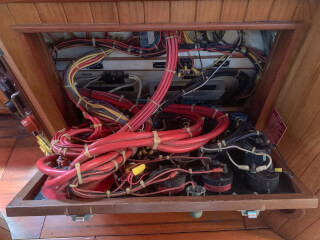
Boat Systems
We also want to the time to do the same to understand the other boat systems including:
- fresh water system
- watermaker
- propane
- toilets (water intake, holding tank, pump out, discharge)
- all through-hulls
- engine fuel
- engine/transmission cooling water
If you want to read more on this topic, The Boat Galley has a great write-up on getting to know your systems.
Thanks for reading!
Share I’m a Tracer with your friends:
Stay up to date with our content releases, by subscribing to our RSS Feed or follow us on Facebook and Instagram.
 If you would like to delve deeper into our adventure as it unfolds, please consider joining the Serenade Wind Crew. Our sister site provides more information on what it means to be part of the crew, unlock the pirate’s booty, and receive other exclusive access and benefits.The first 50 members have a gift waiting.
If you would like to delve deeper into our adventure as it unfolds, please consider joining the Serenade Wind Crew. Our sister site provides more information on what it means to be part of the crew, unlock the pirate’s booty, and receive other exclusive access and benefits.The first 50 members have a gift waiting. 